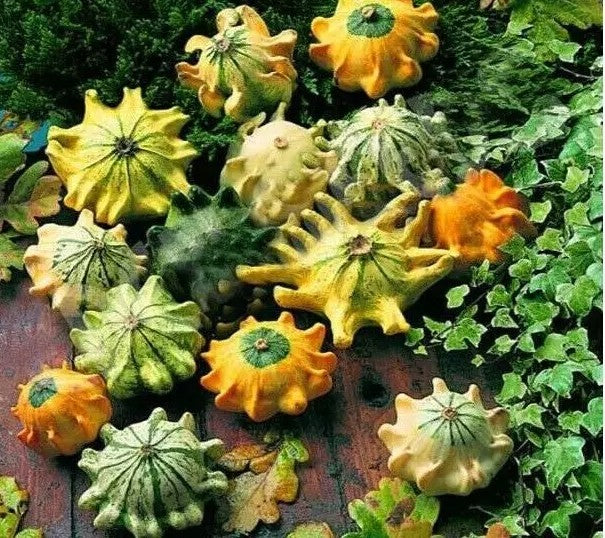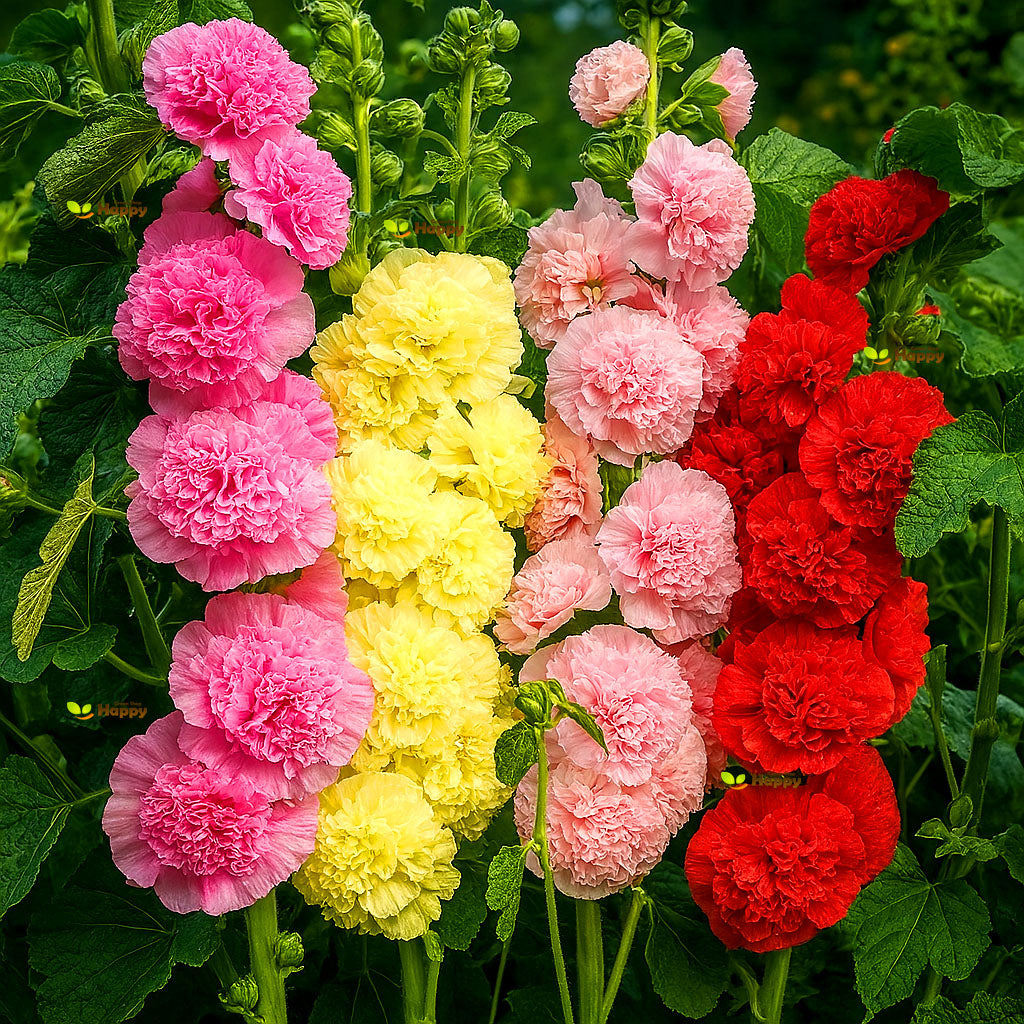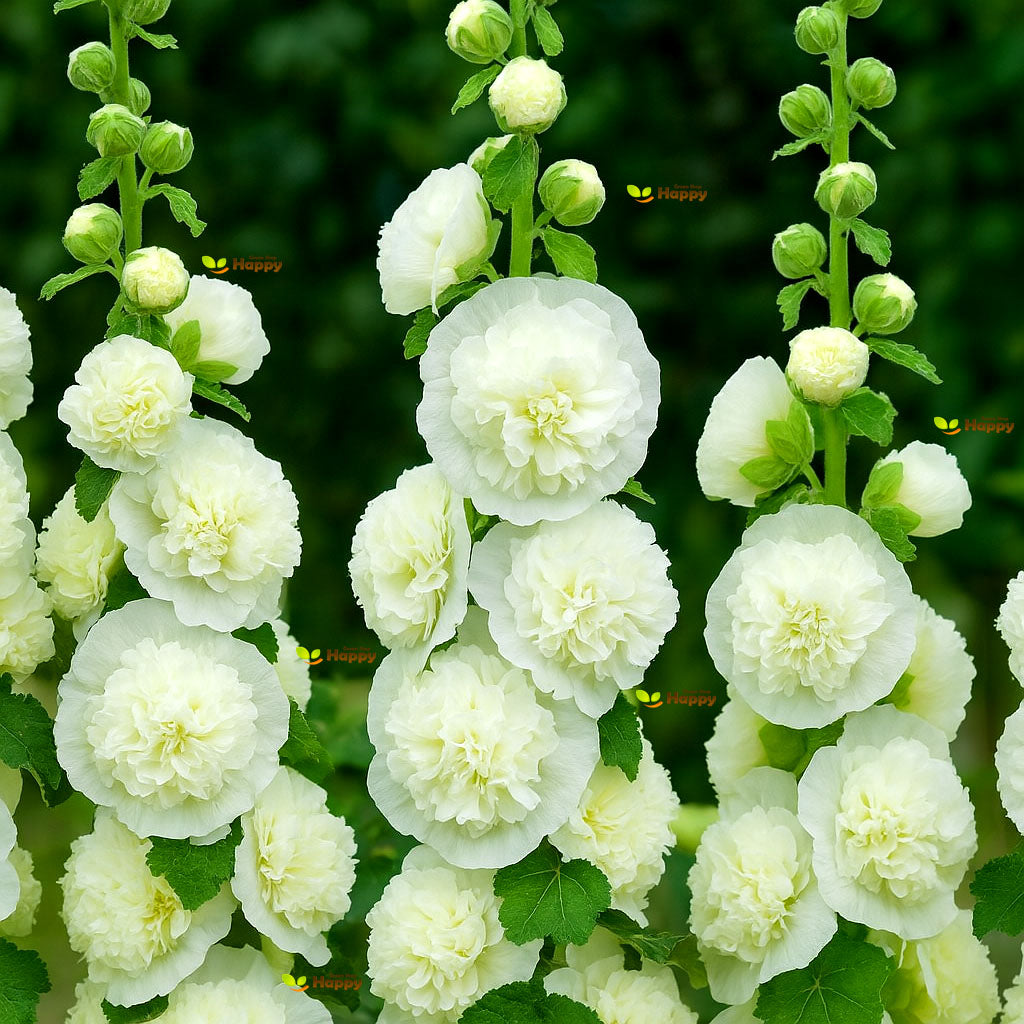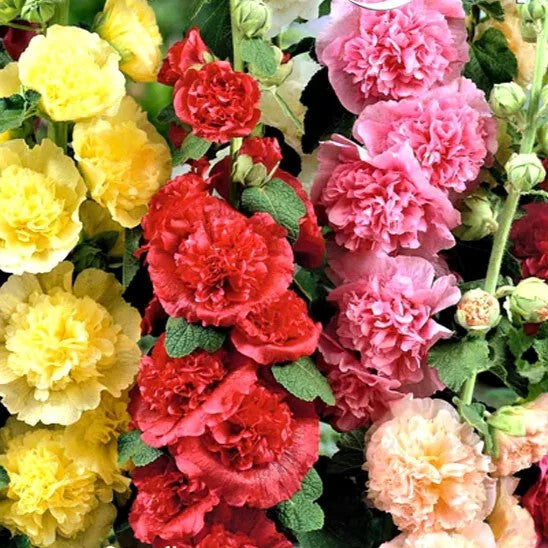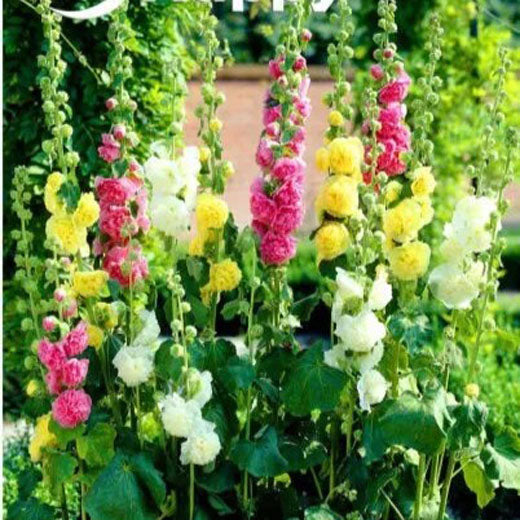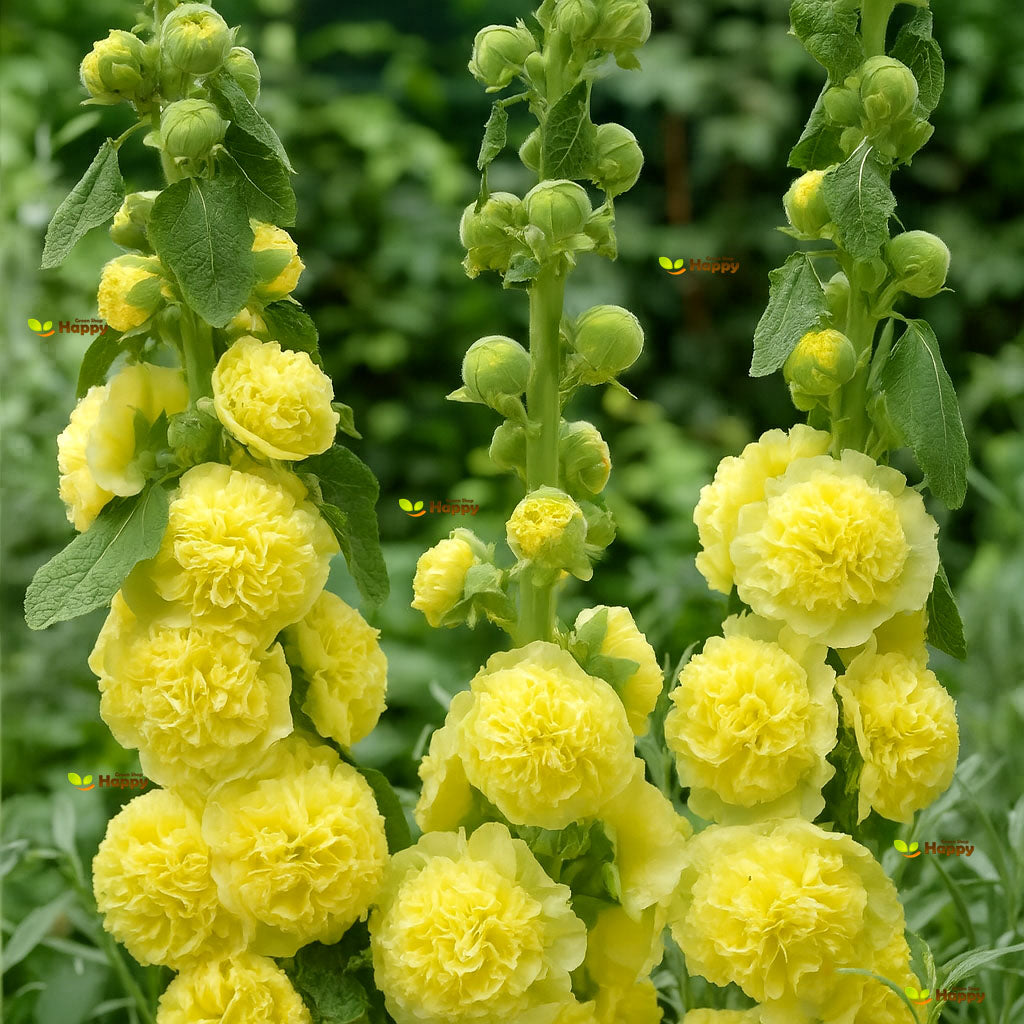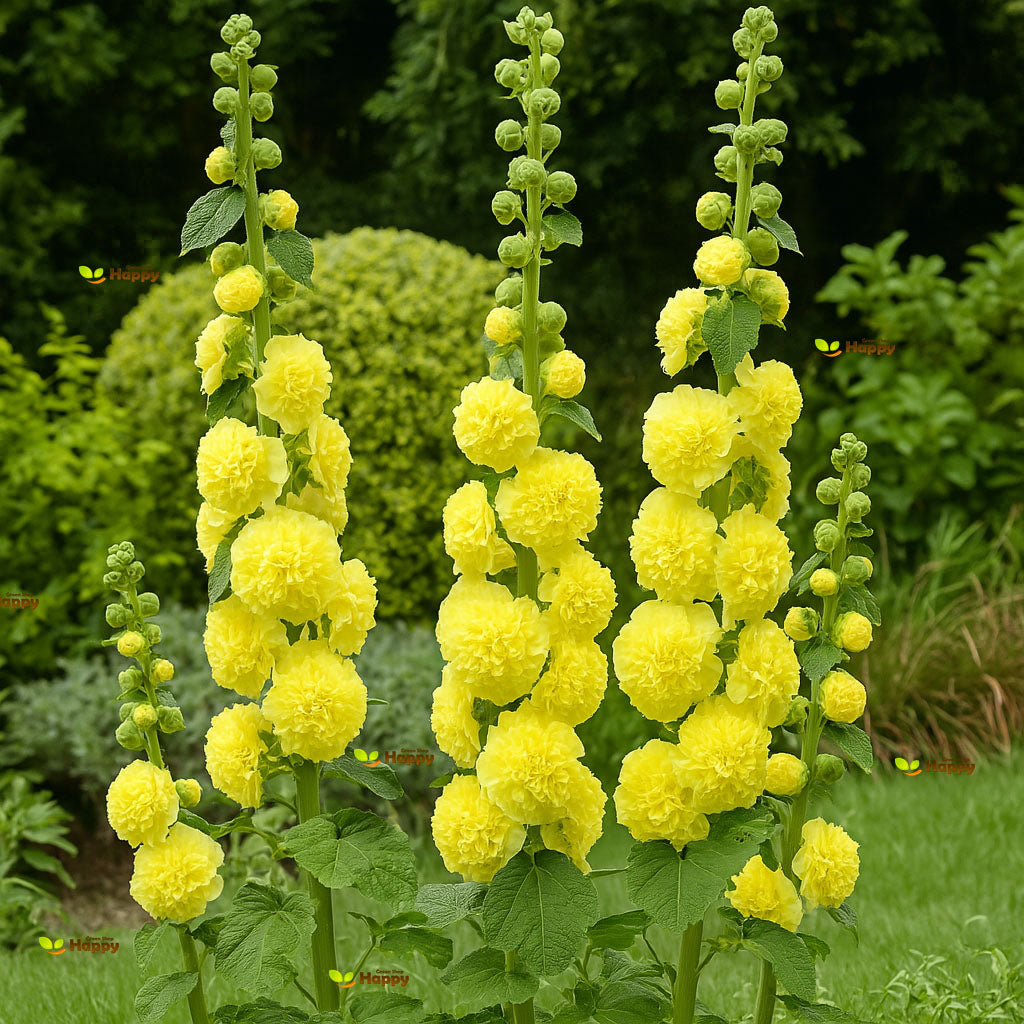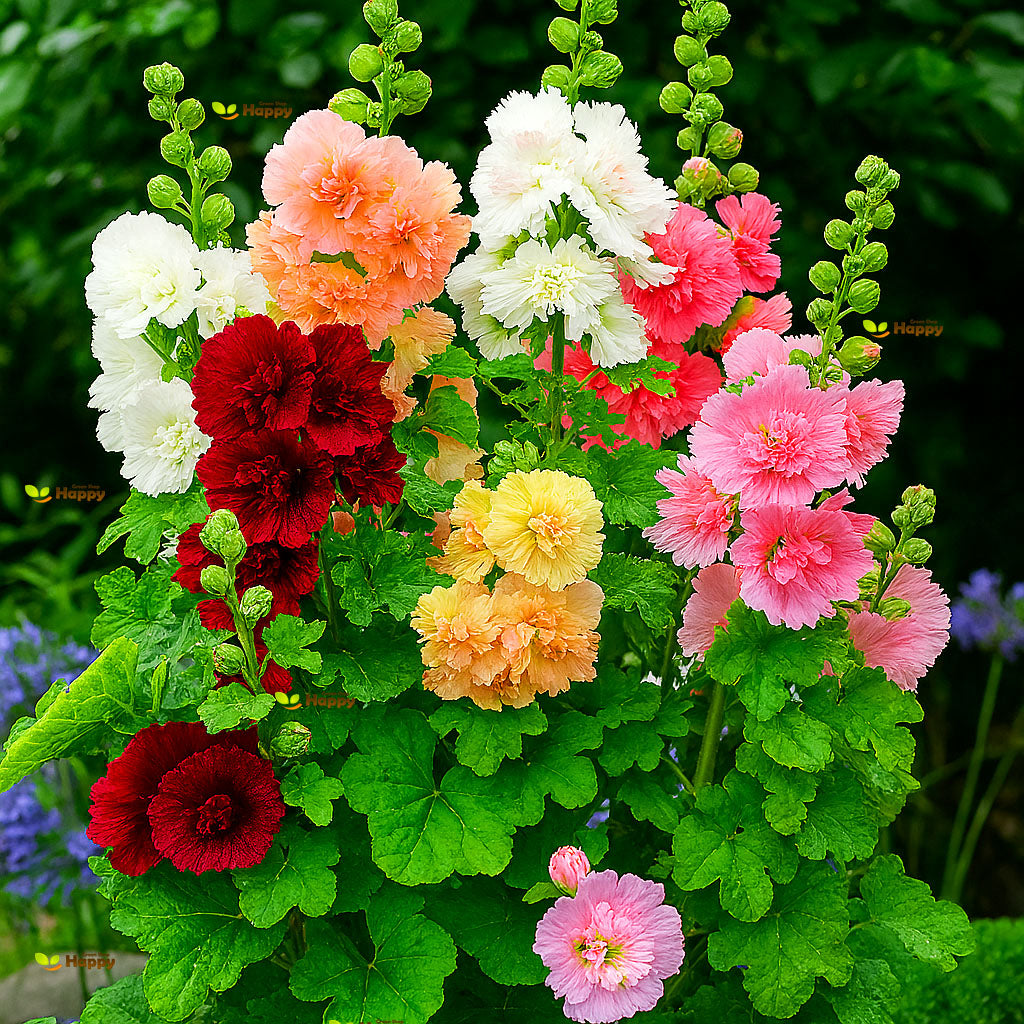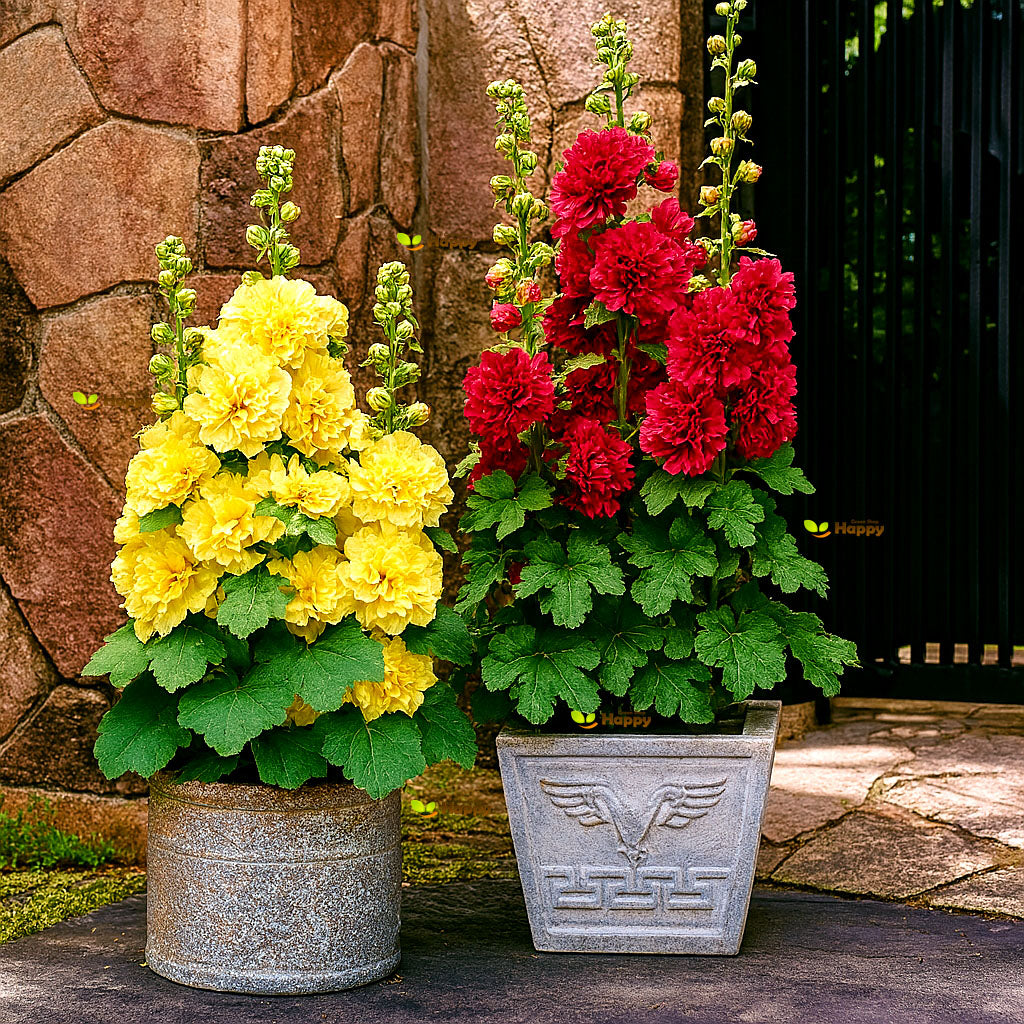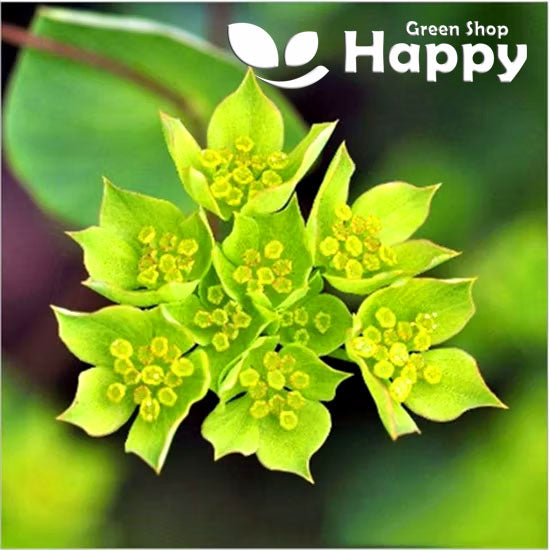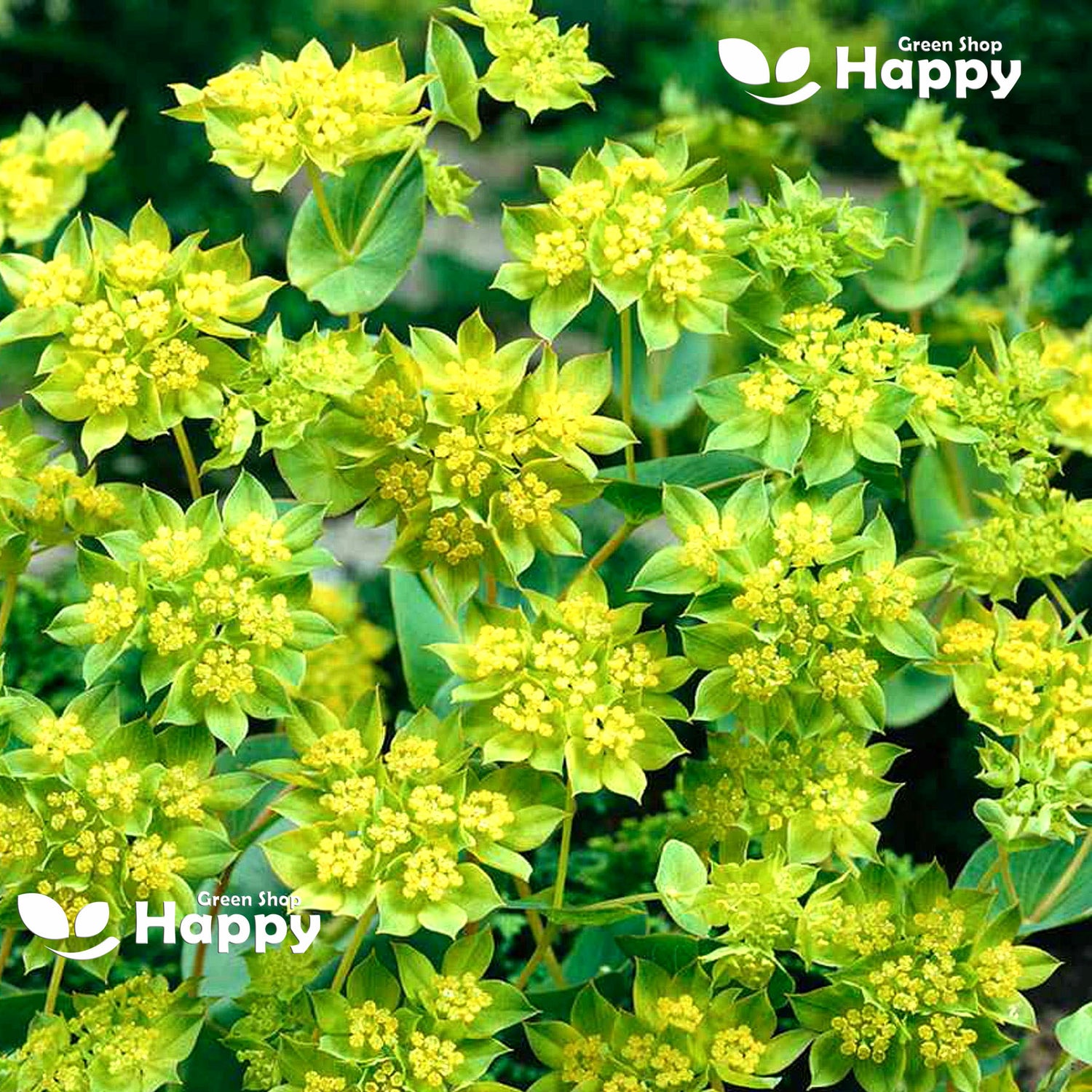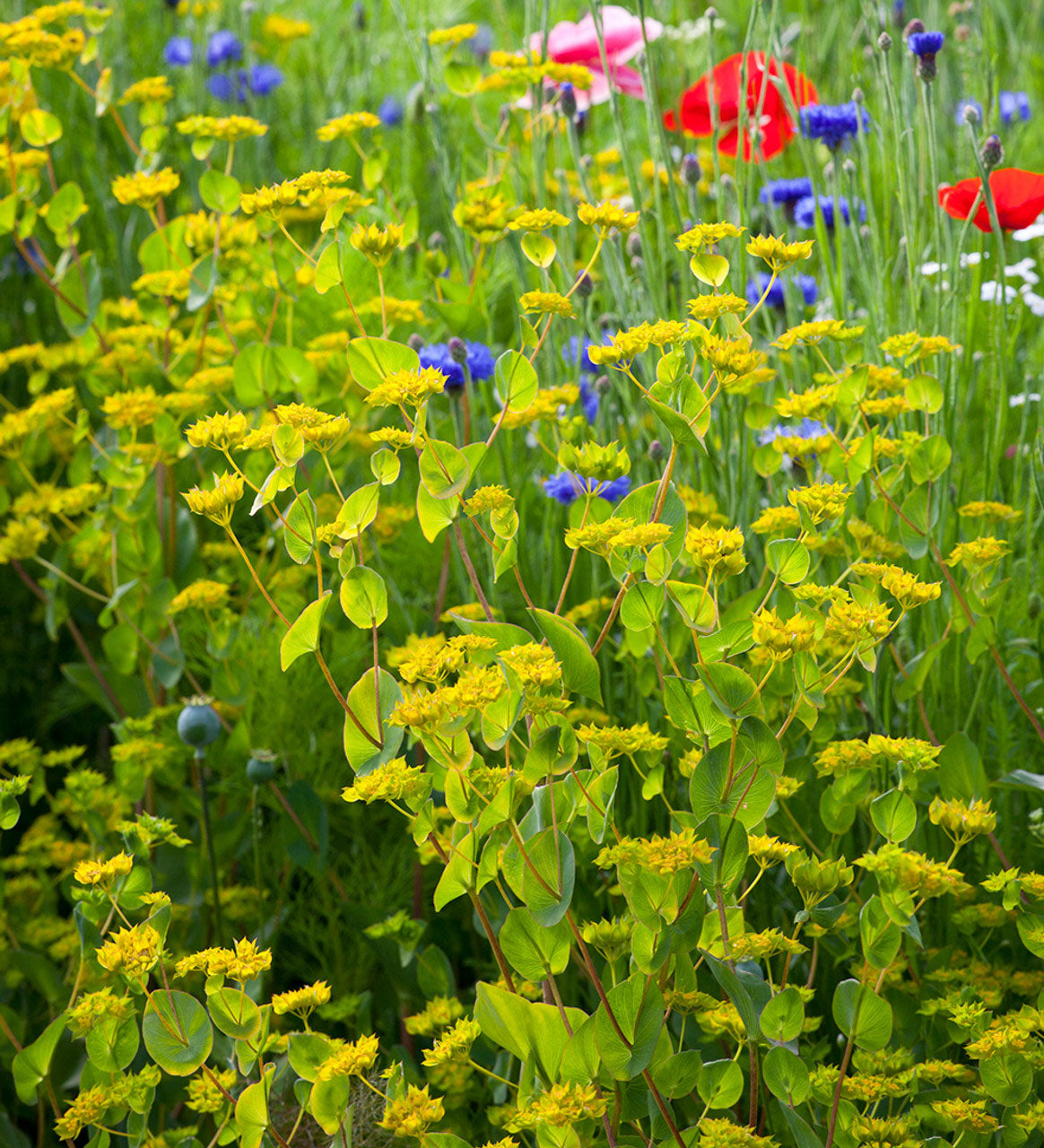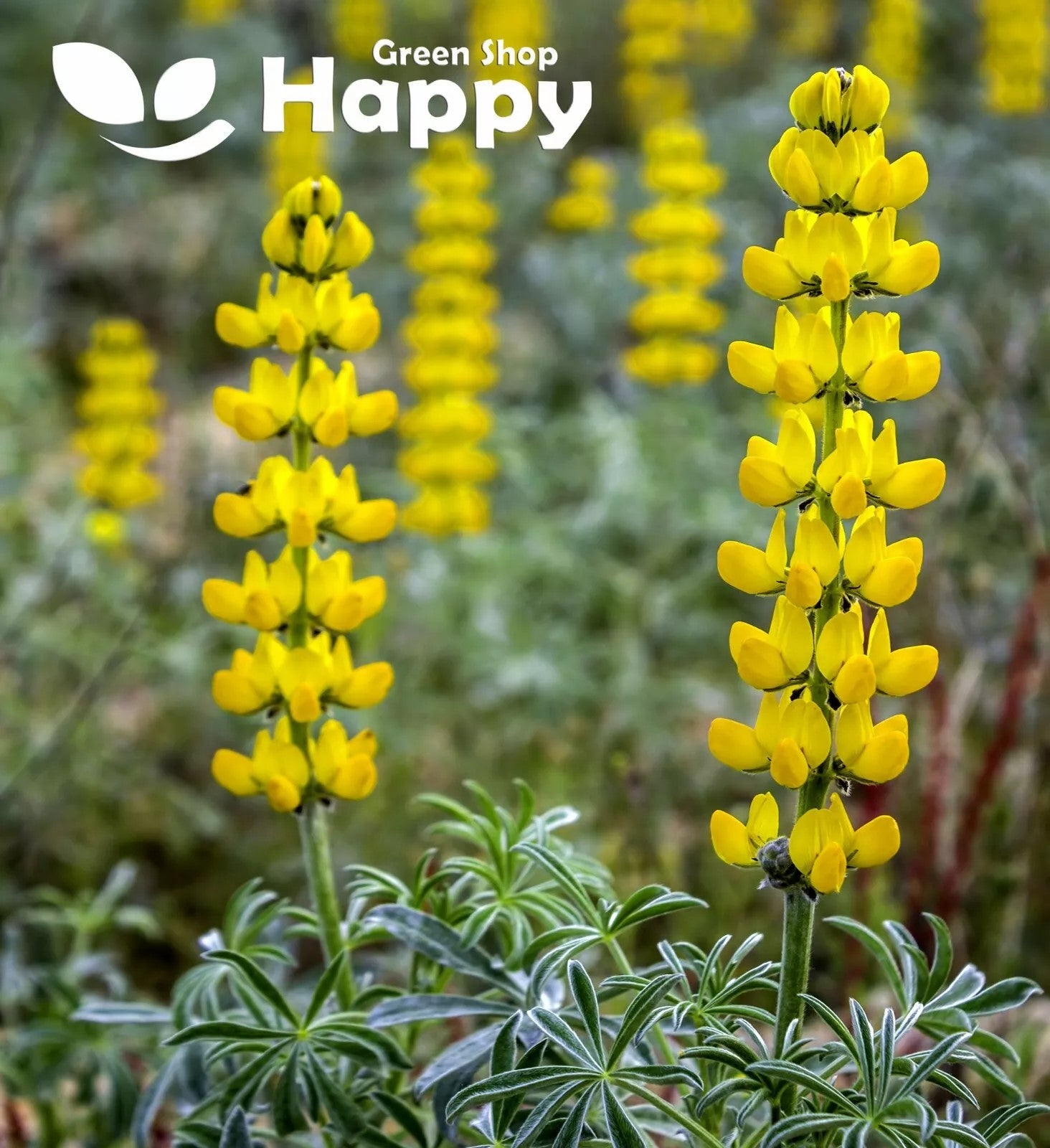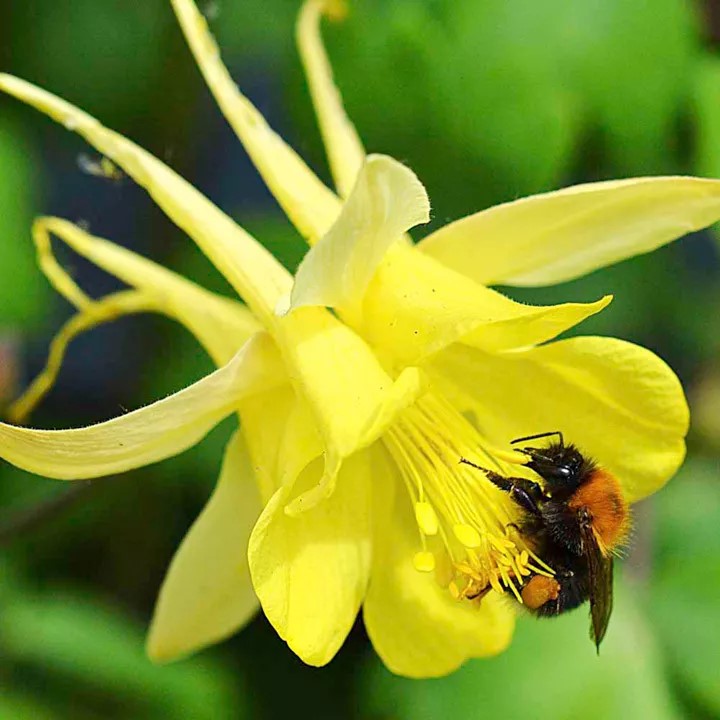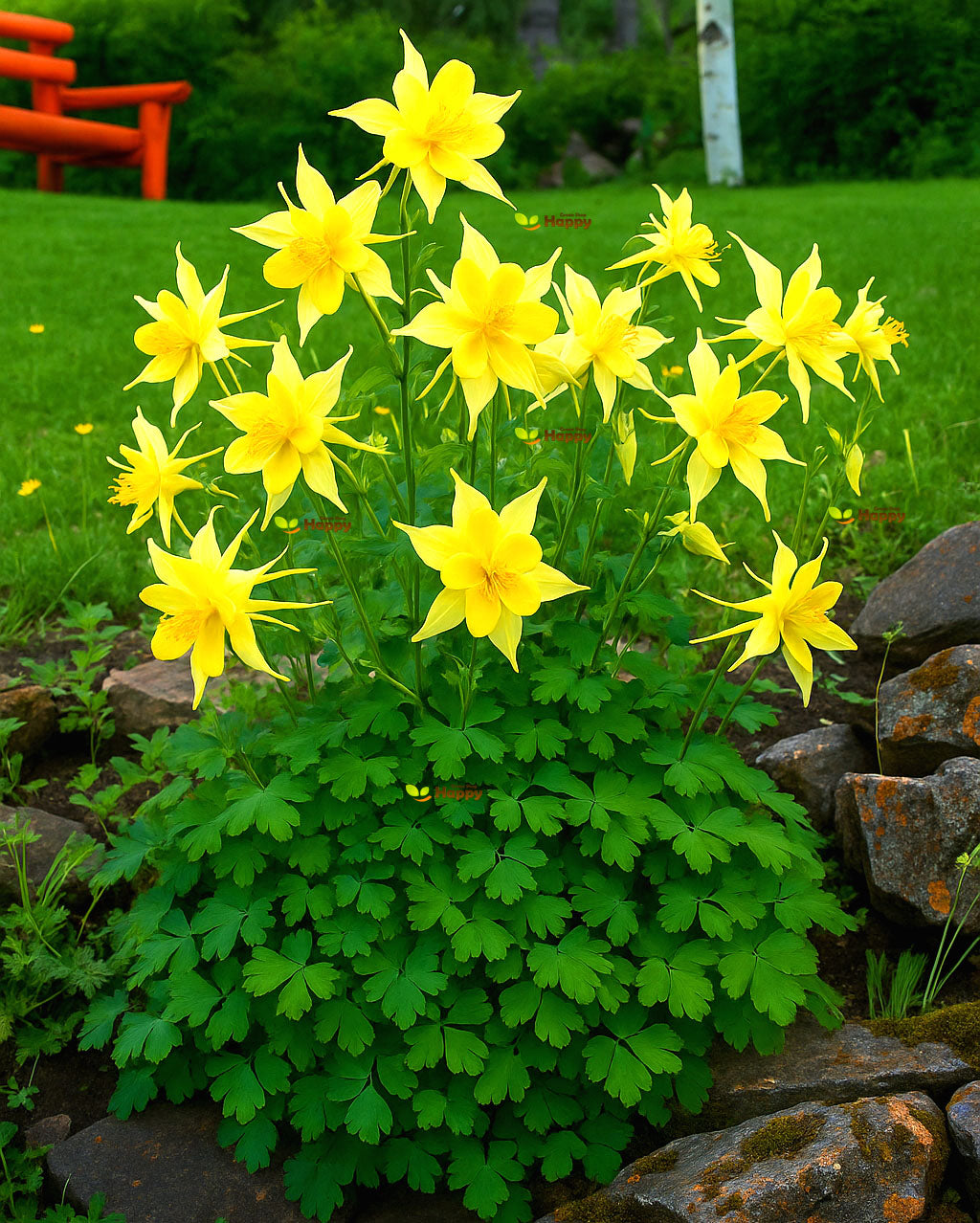Sort by:
351 products
351 products
Hollyhock ‘Chaters Double Triumph Mix’ Seeds (Althaea rosea)
A true cottage garden classic, the Hollyhock ‘Chaters Double Triumph Mix’ produces tall, stately flower spikes adorned with large, fully double blooms in a rich blend of colors – from soft pastels to vibrant shades. These majestic perennials (often grown as biennials) create a dramatic vertical accent at the back of borders, alongside walls, or in wildflower-style gardens.
What Makes It Special
-
Stunning double blooms in a wide range of colors
-
Impressive tall spires up to 1.8–2.5 m high
-
Attracts bees, butterflies, and pollinators
-
A long-standing favorite in cottage and traditional gardens
Key Features
-
Botanical name: Althaea rosea
-
Common name: Hollyhock Chaters Double Triumph Mix
-
Seed count: Approx. per pack (customizable)
-
Height/Spread: 180–250 cm tall, 50–60 cm spread
-
Position: Full sun; well-drained fertile soil
-
Flowering period: July – September (second year from sowing)
-
Lifespan: Hardy biennial/perennial
Ideal For
-
Cottage and traditional garden borders
-
Planting against walls and fences
-
Pollinator-friendly gardens
-
Creating dramatic vertical height in displays
Sowing Instructions
-
When to sow: Indoors March–May or directly outdoors May–June.
-
How to sow:
-
Sow seeds thinly in trays or pots of moist seed compost, cover lightly.
-
Keep at 15–20°C for germination (14–21 days).
-
Transplant seedlings when large enough, spacing 45–60 cm apart.
-
-
Care: Provide support in exposed areas. Deadhead faded flowers to encourage further blooming.
Hollyhock Chaters Double Triumph White – Seeds (Althaea rosea)
Hollyhock Chaters Double Triumph White is a stunning biennial that produces tall spikes of pure white, double blooms. Its elegant flowers create a classic cottage garden look, ideal for borders, backdrops, and pollinator-friendly gardens. Easy to grow and long-lasting, this variety attracts bees and butterflies while adding height and drama to any garden space.
Why Grow "Chaters Double Triumph White"
-
Tall spikes of elegant, double white flowers
-
Long flowering season adds summer interest
-
Attracts pollinators, including bees and butterflies
-
Perfect for cottage garden style and borders
Key Features
-
Type: Biennial (Althaea rosea)
-
Height: 1.8–2.0 m
-
Flowering: Second year after sowing
-
Position: Full sun
-
Uses: Borders, backdrops, cottage gardens, pollinator planting
Ideal For
-
Creating dramatic vertical interest in borders
-
Cottage and mixed garden designs
-
Pollinator-friendly planting
-
Gardeners seeking classic, easy-to-grow hollyhocks
Sowing & Growing
-
Sow indoors: January–March
-
Sow outdoors: Directly in soil April–May
-
Germination: 14–21 days
-
Plant out after last frost, spacing 45–60 cm apart
-
Prefers full sun and well-drained soil
Hollyhock ‘Summer Carnival’ Double Mix Seeds (Althaea rosea)
Hollyhock ‘Summer Carnival’ is a striking biennial with tall spikes of fully double, ruffled blooms in a vibrant mix of colors. Blooming from mid to late summer, it adds drama and vertical interest to borders, cottage gardens, and pollinator-friendly spaces. Hardy and easy to grow, it attracts bees and butterflies while creating a stunning floral display.
What Makes It Special
-
Fully double, ruffled blooms in a vibrant color mix
-
Tall, dramatic flower spikes ideal for vertical accents
-
Attracts pollinators and adds cottage garden charm
Key Features
-
Botanical name: Althaea rosea
-
Biennial
-
Height: 150–200 cm
-
Bloom time: Mid to late summer
Ideal For
-
Borders and cottage gardens
-
Pollinator-friendly plantings
-
Backgrounds, vertical accents, and cut flowers
Sowing
-
Sow indoors Feb–Apr or outdoors Apr–Jun
-
Cover seeds lightly with soil
-
Germination: 14–21 days at 18–22°C
-
Space seedlings 40–50 cm apart
-
Flowers the following year
HOLLYHOCK ‘CHATERS DOUBLE YELLOW’ SEEDS (Althaea rosea)
Add towering elegance and cheerful color to your garden with Hollyhock ‘Chaters Double Yellow’. This classic biennial produces large, double yellow flowers on tall, sturdy stems, creating a stunning vertical display in borders and cottage gardens. Easy to grow and long-flowering, it attracts pollinators while enhancing garden charm.
Why Grow "Chaters Double Yellow"
-
Large, double yellow flowers
-
Tall, sturdy stems for vertical impact
-
Long-flowering and low-maintenance
-
Attracts bees and butterflies
Key Features
-
Type: Biennial (Althaea rosea)
-
Height: 150–200 cm
-
Flowering: Summer (June–August)
-
Position: Full sun
-
Uses: Borders, cottage gardens, tall displays, pollinator-friendly
Ideal For
-
Adding height and color to garden borders
-
Cottage and informal garden designs
-
Attracting pollinators
-
Cut flowers for arrangements
Sowing & Growing
-
Sow indoors: 6–8 weeks before last frost
-
Sow outdoors: After frost danger has passed
-
Germination: 14–21 days
-
Space seedlings: 40–50 cm apart
-
Full sun and well-drained soil for best flowering
Hollyhock ‘Majorette Double’ Mix – Seeds (Althaea rosea)
The Hollyhock ‘Majorette Double’ Mix is a stunning dwarf variety producing fully double flowers in a wide range of colors, including pink, red, yellow, and white. Compact and bushy, it is perfect for smaller gardens, borders, and containers while still giving that classic cottage garden charm.
Why Grow ‘Majorette Double’?
-
Fully double blooms in a vibrant color mix
-
Shorter, dwarf habit compared to traditional tall hollyhocks
-
Long summer flowering season
-
Attracts bees and pollinators
Key Features
-
Type: Half-hardy biennial (often flowers in the first year)
-
Height: 60–80 cm
-
Flowering: June–September
-
Position: Full sun, well-drained soil
-
Uses: Borders, containers, cottage garden plantings
Ideal For
-
Smaller gardens and courtyards
-
Adding vertical interest without excessive height
-
Pollinator-friendly spaces
Sowing & Growing
-
Sow indoors: February–April in trays or pots
-
Sow outdoors: May–June directly in soil
-
Germination: 14–21 days at 18–20°C
-
Transplant seedlings 40–50 cm apart
-
Deadhead faded flowers for extended blooming
Hare’s Ear Seeds (Bupleurum rotundifolium ‘Griffithii’)
Add unique texture and vibrant color to your garden with Hare’s Ear (Bupleurum rotundifolium ‘Griffithii’). This annual produces clusters of bright green, airy umbels above fine foliage, creating a striking contrast in borders, cutting gardens, and wildflower meadows. Hardy and easy to grow, it attracts pollinators and adds architectural interest to your garden.
How to Grow
-
Sow directly outdoors in spring after the last frost.
-
Use well-drained soil in full sun.
-
Scatter seeds thinly and cover lightly with soil.
-
Keep soil moist until germination (10–14 days).
-
Thin seedlings to 25–30 cm apart once established.
-
Cut flowers regularly to encourage continued blooming.
Key Features
-
Airy green umbels for a unique garden texture
-
Hardy annual, easy to grow and long-flowering
-
Excellent for borders, cutting gardens, and meadows
-
Attracts bees, butterflies, and other pollinators
-
Architectural foliage adds interest to plantings
Ideal For
-
Flower borders and cottage gardens
-
Cutting gardens for fresh bouquets
-
Wildflower-style meadows and naturalized areas
-
Pollinator-friendly landscapes
Sowing
-
Best time: Spring outdoors
-
Germination: 10–14 days
-
Sow thinly, cover lightly, and keep soil moist
-
Prefers full sun and well-drained soil
Quick Tip
-
For a longer display, sow in successive batches every 2–3 weeks during spring.
Herb Licorice – Seeds (Glycyrrhiza glabra)
Description:
Grow your own natural sweetener and medicinal herb with Herb Licorice (Glycyrrhiza glabra). This hardy perennial produces long roots renowned for their sweet flavor and traditional herbal uses. With attractive feathery foliage and pale blue-lavender flowers, licorice is both decorative and useful in the garden. Ideal for herb gardens and natural remedy enthusiasts, it thrives in sunny, well-drained soil and rewards patience with valuable roots after two to three years of growth.
Key Features
-
Perennial herb with sweet, aromatic roots
-
Pale blue-lavender summer flowers
-
Valued for culinary and medicinal purposes
-
Attractive feathery foliage
-
Long-lived and easy to maintain once established
Ideal For
-
Herb and medicinal gardens
-
Cottage and wildlife gardens
-
Edible landscapes
-
Homegrown natural remedies
Sowing & Growing
-
Sow Indoors: February–April
-
Transplant Outdoors: May–June
-
Germination: 14–21 days at 18–22°C
-
Spacing: 45–60 cm apart
-
Height: 90–120 cm
-
Light: Full sun
-
Soil: Deep, fertile, well-drained
Care Tips
-
Water regularly during dry periods
-
Harvest roots after 2–3 years of growth
-
Mulch to retain soil moisture
-
Protect from frost in colder climates
Golden Yellow Lupine Seeds (Lupinus luteus)
Golden Yellow Lupine produces tall, striking spires of bright yellow pea-like flowers above lush green foliage. Hardy and fast-growing, it adds vertical interest and vibrant color to borders, cottage gardens, and wildflower meadows. Loved by bees and other pollinators, it also fixes nitrogen in the soil, improving garden fertility naturally.
What Makes It Special
-
Brilliant yellow flower spikes for dramatic garden color
-
Hardy, easy-to-grow perennial that attracts pollinators
-
Improves soil fertility through nitrogen fixation
Key Features
-
Botanical name: Lupinus luteus
-
Hardy annual or short-lived perennial
-
Height: 80–120 cm (32–48 in)
-
Bloom time: Early to mid-summer
Ideal For
-
Cottage gardens, perennial borders, and wildflower meadows
-
Pollinator-friendly plantings
-
Adding vertical interest and vibrant yellow color
Sowing
-
Sow indoors Mar–Apr or outdoors Apr–Jun
-
Nick or scarify seeds and soak overnight for faster germination
-
Cover lightly with soil and keep moist
-
Germination: 14–30 days at 15–20°C
-
Thin seedlings 30–40 cm apart
-
Flowers the first or second year
Golden Columbine Seeds (Aquilegia chrysantha)
Bright and graceful, Golden Columbine produces striking yellow, spurred flowers that nod delicately above fern-like foliage. Native to North America, this hardy perennial is known for its long spurs and cheerful color, bringing light and elegance to borders, rock gardens, and natural plantings. Highly attractive to hummingbirds, bees, and butterflies.
What Makes It Special
-
Brilliant golden-yellow blooms with long spurs
-
Native perennial, hardy and easy to grow
-
Excellent for pollinator-friendly gardens
Key Features
-
Botanical name: Aquilegia chrysantha
-
Hardy perennial
-
Height: 60–90 cm (24–36 in)
-
Bloom time: Late spring to early summer
Ideal For
-
Cottage and rock gardens
-
Wildlife and pollinator-friendly spaces
-
Naturalized and woodland plantings
Sowing
-
Sow indoors Feb–Apr or outdoors Apr–Jun
-
Lightly cover seeds; needs some light to germinate
-
Germination: 21–35 days at 15–20°C
-
Thin seedlings 30 cm apart
-
Flowers from the second year after sowing
Showing 198/351



